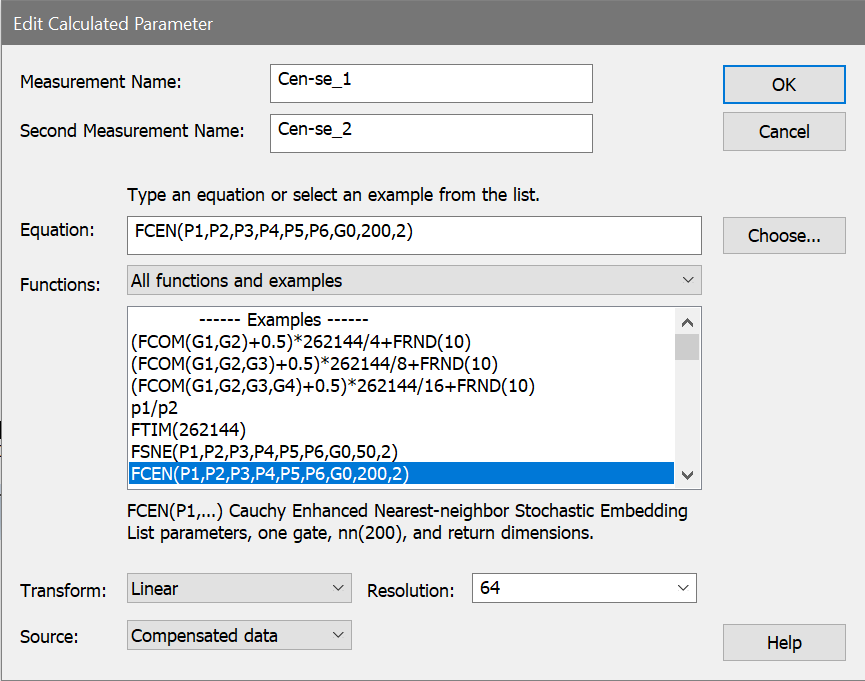
This dialog is used to create and edit calculated parameters. It is displayed from the Add Parameters dialog.
One of the best ways to get started with a calculated parameter is to review the list of examples in the Functions listbox and select one that is similar to what you want to create. With an example selected, it is a simple matter to edit the specifics of the equation for your data.
The Measurement Name field can be any text you want. This is the name that will be displayed for this new calculated parameter on histograms and in parameter lists Some functions (FSNE and FCEN) create two measurements, and a second name field appears for those functions.

Equation
Type an equation or select one from the example list to set this field. The equation can include parentheses for grouping, and supports +, -, *, and / operators. The parameters and their names are shown in a separate list box. The parameter and function letters are not case sensitive. For example, p1*2.5 is the same as P1*2.5.
When the Equation field contains FCEN or FSNE functions, the Choose... button is displayed next to the edit box. This button allows the user to select parameters for the FCEN or FSNE function quickly and efficiently.
Choose...
When the Equation field contains FCEN or FSNE functions, the Choose button is displayed next to the edit box. It allows you to select measurements to be used by the functions.
Parameters dialog box
A separate dialog box will be displayed showing the available measurements. The dialog will automatically be put away when you select either Cancel or OK.
Functions
All functions and examples are shown in this list box. A drop-down list allows you to show functions, examples, or both in the function list. Notice that all the functions start with the letter F.
FCOM(g1, g2, gn) |
Gate combination function. The argument is a list of any number of gates separated by commas. See FCOM Background for further explanation. |
FTIM(adcResolution) |
Creates a chronological time variable over the number of channels, adcResolution, specified in the argument. This parameter allows you to gate out bad runs with DNA or to even perform kinetics calculations (assuming you are not interested in absolute time). |
FSNE(p1,p2,...,g0,50,2) |
This function creates "t-SNE" (t-Distributed Stochastic Neighbor Embedding) parameters. The t-SNE function does a great job of reducing dimensionality to 2 dimensions. One FSNE equation will create 2 t-SNE parameters in the output. The first "p" arguments are parameters for the t-SNE function. Next is the "g" argument, which specifies a gate. Perplexity (50) sets the number of effective nearest neighbors. The last argument is 2, specifying the number of dimensions to return. See Population Identification with Cen-se' and t-SNE for further explanation. |
FCEN(p1,p2,...,g0,200,2) |
This function creates "Cen-se" (Cauchy Enhanced Nearest-neighbor Stochastic Embedding) parameters. The function is a significant enhancement of the t-SNE algorithm, producing better resolution of clusters with more separation. One FCEN equation will create 2 Cen-se parameters in the output. The first "p" arguments are parameters for the FCEN function. Next is the "g" argument, which specifies a gate. The number of nearest neighbors to consider (200) is the next argument. The last argument is 2, specifying the number of dimensions to return. See Population Identification with Cen-se' and t-SNE for further explanation. |
FLOG(param) |
Returns the natural log of param. Negative numbers and zero are evaluated to 0 since they are illegal values for log functions. |
FL10(param) |
Returns the log to the base 10 of param. Negative numbers and zero are evaluated to 0 since they are illegal values for log functions. |
FEXP(param) |
Raises natural log to the param power. |
FE10(param) |
Raises 10 to the param power. |
FSQR(param) |
Returns the square of param. |
FCUB(param) |
Returns the cube of param. |
FPWR(base, power) |
Returns the value of base to the power. |
FRND(variance) |
Returns a random number with variance variability. If zero is entered as the argument, then it returns a uniform random number between 0 and 1. |
FSIN(x) |
returns the sine of x, where x is in radians. |
FCOS(x) |
returns the cosine of x, where x is in radians. |
FTAN(x) |
returns the tangent of x, where x is in radians. |
FCTN(x) |
returns the cotangent of x, where x is in radians. |
FASN(x) |
returns the arcsine of x, where x ranges from -1.0 to 1.0. Values for x outside of this range are forced to the nearest limit. |
FACS(x) |
returns the arccosine of x, where x ranges from -1.0 to 1.0. Values for x outside of this range are forced to the nearest limit. |
FATN(x) |
returns the arctangent of x. |
FACN(x) |
returns the arccotangent of x, equivalent to arctangent of 1/x. |
FV2S(param) |
Returns param to the 2/3's power. Negative numbers and zero are evaluated to 0 since they are illegal values for log functions. |
FS2V(param) |
Returns param to the 3/2's power. Negative numbers and zero are evaluated to 0 since they are illegal values for log functions. |
|
|
Transform
Sets the transform to be used for displaying the calculated parameter.
Source
In most cases, the calculated parameter can be computed on compensated or uncompensated data. A few functions (FCOM, FSNE, FTIM) ignore of this setting.
Resolution
Choose a resolution to use for the new calculated parameter. The list of resolutions is limited to the resolutions of parameters in the data file.
OK
Accepts the changes to the equation and other settings and closes the dialog.
Cancel
Cancels the changes to the question. If the equation is being created, clicking the Cancel button will flag the equation to be deleted.
See also: